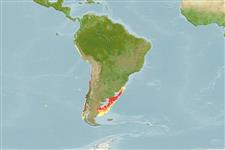Common names from other countries
Environment: milieu / climate zone / depth range / distribution range
Écologie
; profondeur 0 - 90 m (Ref. 87801). Subtropical
Southwest Atlantic and Southeast Pacific. Subtropical and temperate.
Length at first maturity / Taille / Poids / Âge
Maturity: Lm ? range ? - ? cm
This species is found under hard substrate like stones on silty sediment from intertidal areas to a depth of 90 meters (Ref. 87801).
Life cycle and mating behavior
Maturité | Reproduction | Frai | Œufs | Fécondité | Larves
Members of the class Polyplacophora are mostly gonochoric. Life cycle: Eggs hatch into lecitotrophic planktonic trocophore larvae (no veliger stage) which later metamorphose and settle on the bottom as young adults.
Häussermann, V. and G. Försterra. 2009. (Ref. 87801)
Statut dans la liste rouge de l'IUCN (Ref. 130435)
statut CITES (Ref. 108899)
Not Evaluated
Not Evaluated
Menace pour l'homme
Harmless
Utilisations par l'homme
| FishSource |
Outils
Plus d'informations
Taille/Âge
Croissance
Longueur-poids
Longueur-longueur
Morphologie
Larves
Abondance
Sources Internet
Estimates based on models
Preferred temperature
(Ref.
115969): 13.7 - 16.1, mean 14.9 (based on 72 cells).
